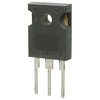-
The maximum operating temperature range for the STW20NC50 is -40°C to 150°C, but it's recommended to operate within -40°C to 125°C for optimal performance and reliability.
-
To ensure proper biasing, make sure to provide a stable voltage supply within the recommended range (VCC = 3.3V ± 10%), and ensure that the input signals are within the specified voltage range (VIN = 0 to VCC). Additionally, decouple the power supply with a 10uF capacitor to reduce noise and ensure stable operation.
-
For optimal thermal management, it's recommended to use a 4-layer PCB with a solid ground plane, and to place the device on a thermal pad connected to a heat sink or a metal plate. Ensure that the PCB layout is designed to minimize thermal resistance and provide good heat dissipation. Refer to the STMicroelectronics application note AN1825 for more detailed guidelines.
-
The STW20NC50 has built-in ESD protection, but it's still recommended to follow proper ESD handling procedures during assembly and testing. Use an ESD wrist strap or mat, and ensure that the device is stored in an ESD-protected environment. Additionally, consider adding external ESD protection devices, such as TVS diodes, to further protect the device from electrostatic discharge.
-
For accurate testing and measurement, use a high-impedance probe or a differential probe to minimize loading effects. Ensure that the measurement equipment is properly calibrated and configured for the specific test conditions. Refer to the STMicroelectronics application note AN1825 for more detailed guidelines on testing and measurement procedures.
 STW20NC50 datasheet
by STMicroelectronics
STW20NC50 datasheet
by STMicroelectronics
Findchips
 STW20NC50 datasheet
by STMicroelectronics
STW20NC50 datasheet
by STMicroelectronics
 Findchips
Findchips